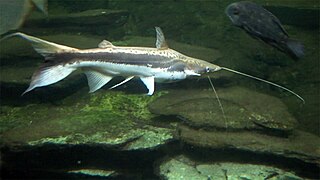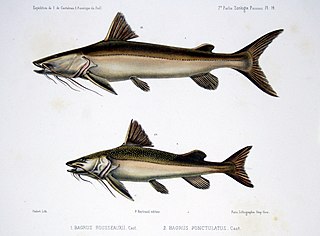
Pseudoplatystoma is a genus of several South American catfish species of family Pimelodidae. The species are known by a number of different common names. They typically inhabit major rivers where they prefer the main channels and tend to stay at maximum depth, but some species can also be seen in lakes, flooded forests, and other freshwater habitats. They have robust bodies, and are important food fish. Recently, their population size has been on the drastic decline due to a variety of factors including overfishing and habitat destruction due to the construction of hydroelectric dams.

The Pimelodidae, commonly known as the long-whiskered catfishes, are a family of catfishes.

Trichomycterus is a genus of fish in the family Trichomycteridae, the largest genus of its family with over 170 species currently described. This genus is native to freshwater habitats in Central and South America. These fish are generally small, usually about 5 to 15 cm (2–6 in) in standard length, although the largest, T. rivulatus, can reach more than twice this size. Species differ from one another primarily in body proportions, fin ray counts and colouration. Despite their relatively small size, some, such as T. punctulatus, support fisheries and are important in the local cuisine.

Sorubim is a small genus of long-whiskered catfish native to tropical South America. A number of characteristics allows the differentiation of each species in the genus. Sorubim species are important food fish in South America and are highly significant to fisheries of some areas; however, harvests of these fish are not identified as much as other, more popular food fishes such as Colossoma, Arapaima, and Brachyplatystoma. Some species of this family are popular aquarium fish.

Brachyplatystoma is a genus of catfish from the family Pimelodidae. As the occasionally used common name goliath catfishes indicates, this genus includes some of the largest species of catfish, including the piraíba, B. filamentosum, which reaches up to the region of 3.6 metres (12 ft) in length. Brachyplatystoma are found in the Amazon and Orinoco basins, and other tropical freshwater and brackish habitats in South America. Some species are migratory. These fish are important as food fish and, to some extent, aquarium fish.
Propimelodus is a genus of South American catfish of the family Pimelodidae.
Exallodontus aguanai is a catfish species of the monotypic genus Exallodontus of the family Pimelodidae. This genus and species was described in 1991. This species reaches 20 centimetres (7.9 in) SL. This species is native to the Amazon and Orinoco River basins of Brazil, Colombia, Peru and Venezuela. Exallodontus is classified under the "Calophysus-Pimelodus clade". Within this clade, it is considered a part of the "Pimelodus-group" of Pimelodids, which also includes Pimelodus, Duopalatinus, Cheirocerus, Iheringichthys, Bergiaria, BagropsisParapimelodus, Platysilurus, Platystomatichthys, and Propimelodus.

The porthole shovelnose catfish or spotted shovelnose catfish, Hemisorubim platyrhynchos, is the only species in the genus Hemisorubim of the catfish family Pimelodidae.

The gilded catfish or jau is a South American catfish of the family Pimelodidae. It is also known as manguruyu or black manguruyu.
Iheringichthys is a small genus of long-whiskered catfish native to South America.

Platysilurus is a genus of long-whiskered catfishes native to South America.
Zungaropsis is a genus of catfish of the family Pimelodidae. It is a monotypic genus, containing only the single species Zungaropsis multimaculatus, and is considered closely related to Zungaro. In 2003, Zungaropsis was considered as a genus inquirendum of the Pimelodidae.

Pimelodus is a genus of fish in the family Pimelodidae native to Central and South America.
Hypophthalmus is a genus of long-whiskered catfishes native to freshwater in tropical and subtropical South America.
Paracanthopoma parva is a species of catfishes of the family Trichomycteridae. P. parva grows to about 2.7 centimetres (1.1 in) SL and is endemic to Brazil where it occurs in the Amazon and Essequibo River basins.
Paravandellia is a genus of pencil catfishes native to South America.
Corumbataia britskii is a species of armored catfish endemic to Brazil where it is found in small tributaries of the Sucuriú River, upper Paraná River Basin in the state of Mato Grosso do Sul. This species was found in deforested areas in moderate to fast current streams. It associates with aquatic macrophytes or the submerged portion of marginal vegetation. In its gut contents were found filamentous blue-green algae, chlorophytes, diatoms and bark. This species grows to a length of 2.7 centimetres (1.1 in) SL.
Corumbataia cuestae is a species of armored catfish endemic to Brazil where it is found in small streams of the Tietê River. This species grows to a length of 3.3 centimetres (1.3 in) SL.
The Highwaterman catfish, is a species of pelagic potamodromous catfish of the family Pimelodidae that is native to Guyana, Suriname, Venezuela, northern Brazil and Gulf of Paria.
Hypophthalmus oremaculatus, is a species of demersal catfish of the family Pimelodidae that is native to Paraná River basin of Argentina and Brazil.










